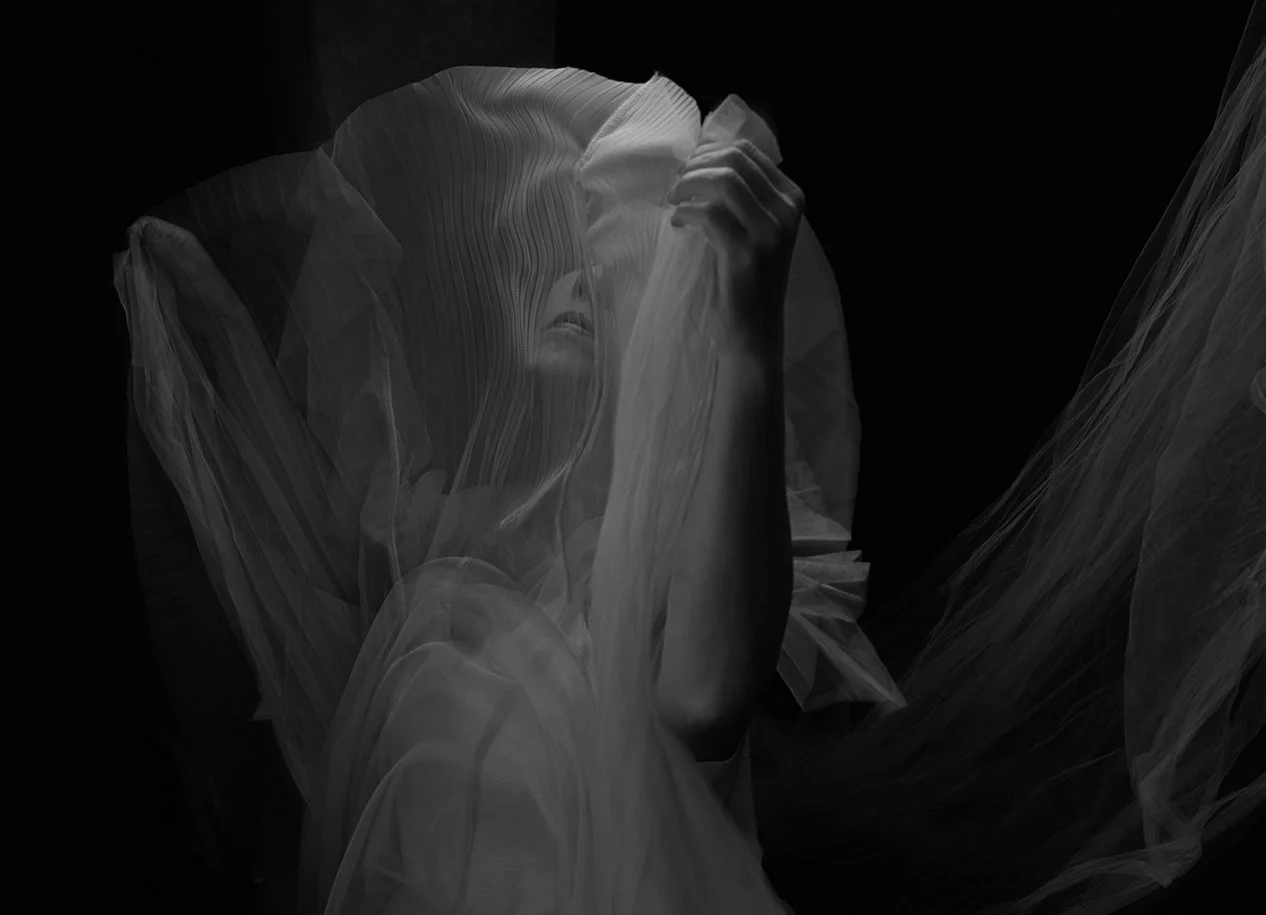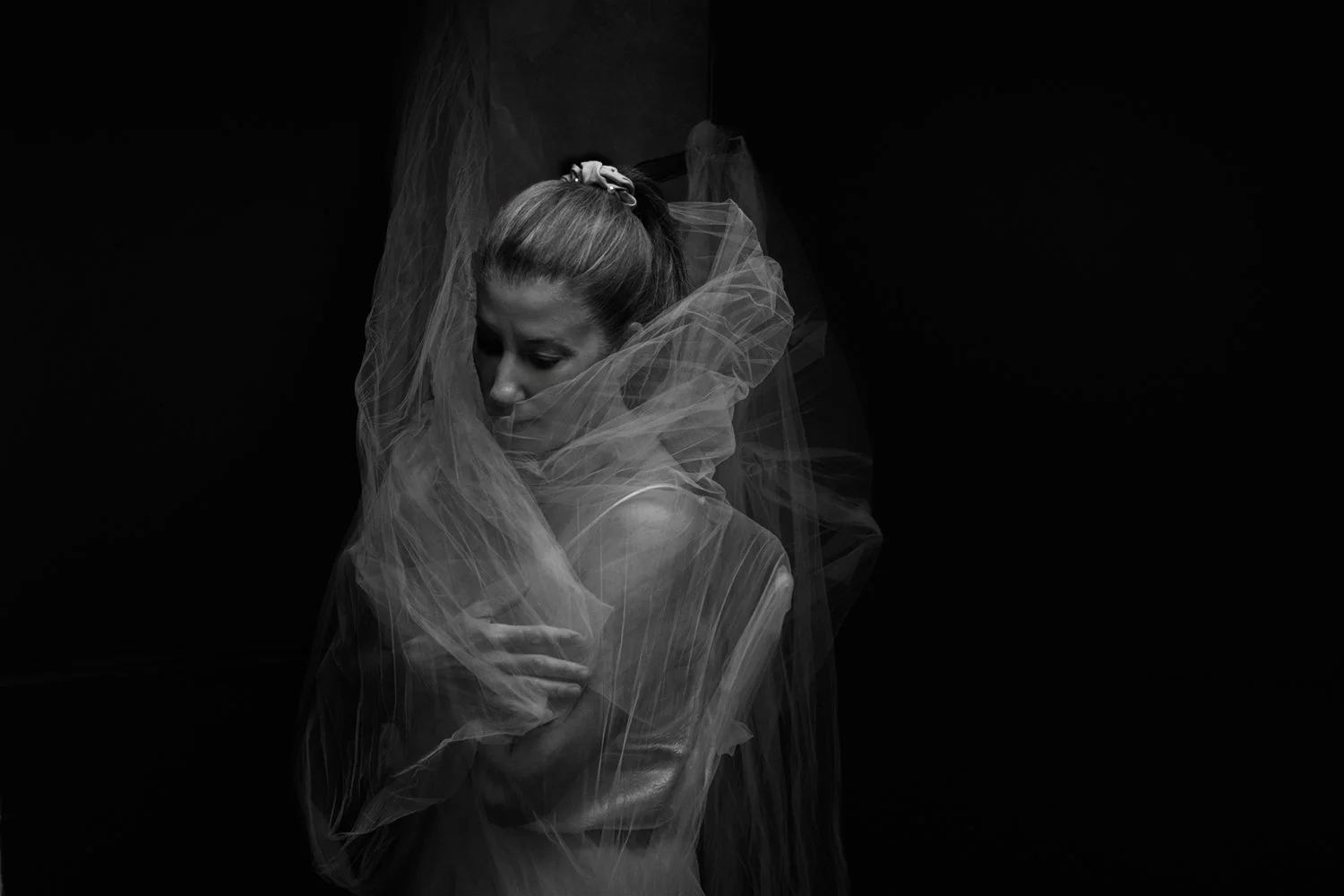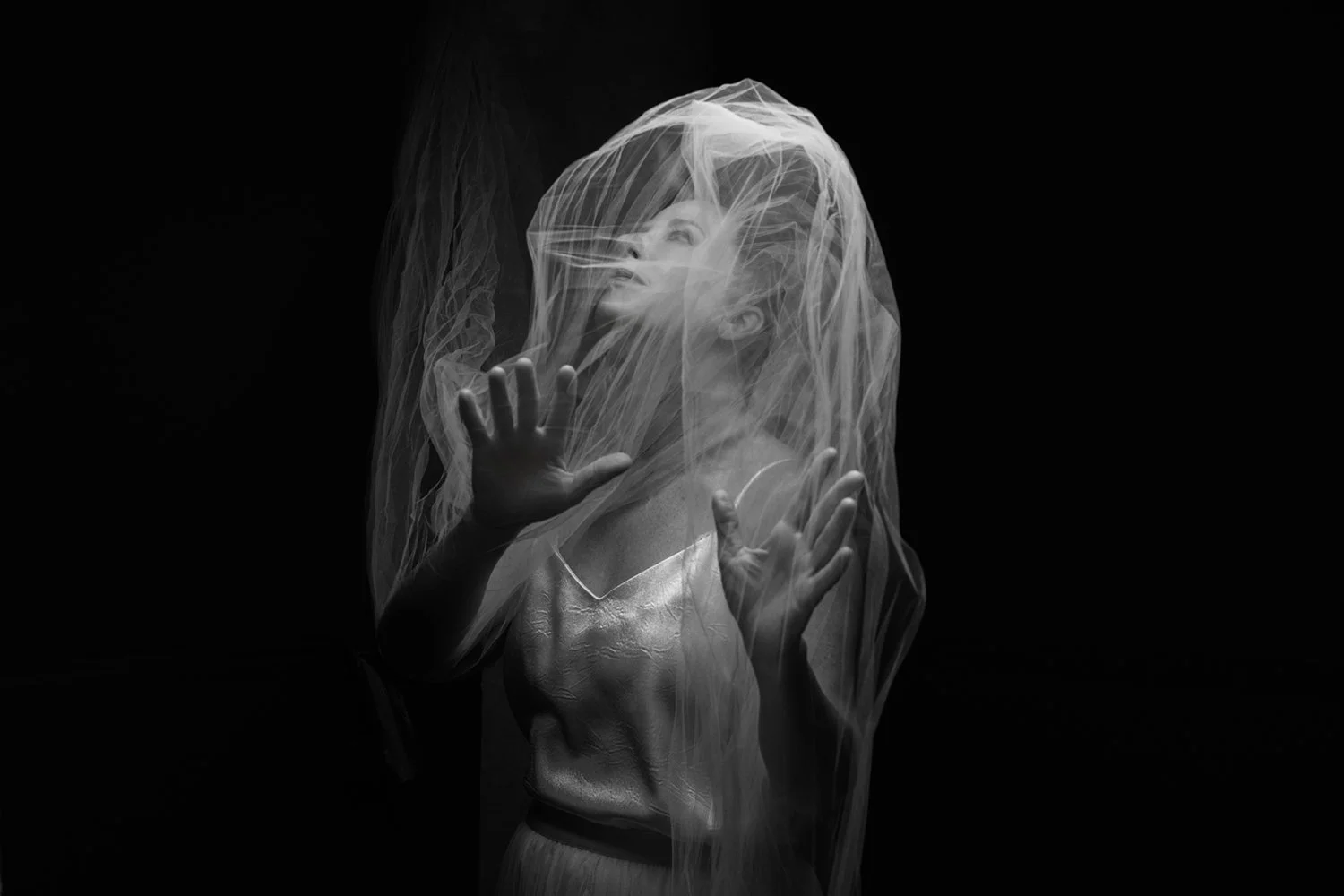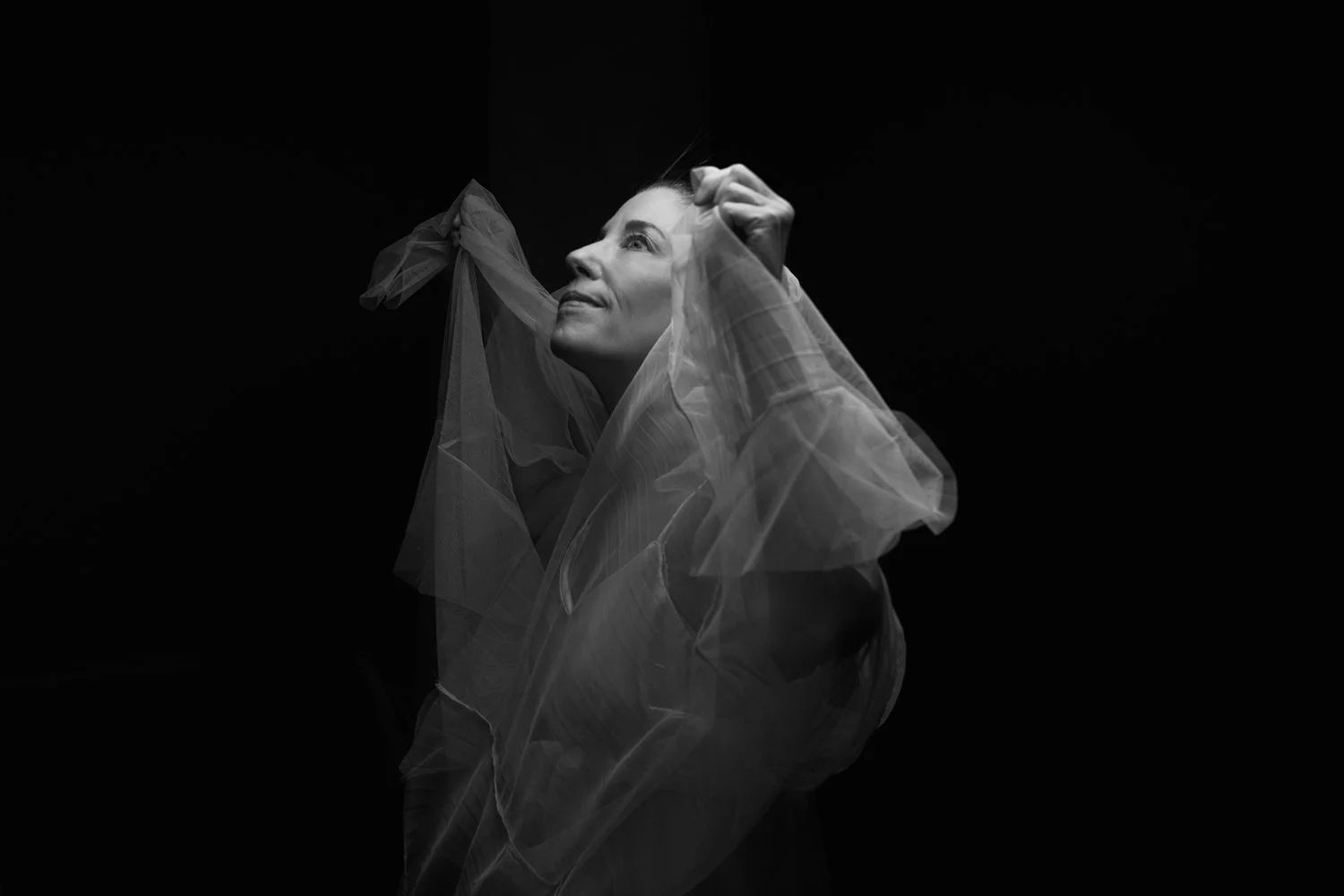How Grief Changes Your Perspective: A Photographer's Journey Back to Living and Business
This self-portrait series represents is how one plunges and resurfaces multiple times within the mourning process. Grief can be like a shroud. There are even moments when grief begins to feel normal and comfortable. Even though you know you can’t stay in this space forever --it’s what connects you to your person. At times you feel tangled up in it, fighting, unable to see the surface, until one day the sun actually caresses your face.
There's no roadmap for this, no step-by-step guide that tells you when you're ready to fully step back into your life, work, and purpose. It’s been over two years since my husband, Tim, unexpectedly passed away in May, and I’ve been learning how grief changes your perspective in ways I never could have imagined—navigating a world that looks the same but feels completely different, a world without him.
Photography has always been more than my occupation. It's part of my soul, how I find meaning in light and shadow, joy and sorrow, and the contrasting rhythms that shape life. So, when grief crashed into my world, I wondered if I could still do this work. If I could still shine light on others when my own felt so dark. This is my story, and I hope it meets you with tenderness wherever you are in your own journey.
How Grief Changes Your Perspective: A Photographer's Journey Back to Life and Business
1. The Messy Middle: When Traditional Support Falls Short
sinking into grief
I’ve hesitated to speak openly about what I call the messy middle—the space between the initial shock of loss and everything else that follows. It’s where fear, anxiety, sadness, and loneliness become your daily companions. You try to push them away, even just for an hour, but they always snap back—sudden and unforgiving, like a taut rubber band being released.
What I discovered during this time was something author Carolyn Moor captures perfectly:
"The existing support structures either infantilized us, pitied us or expected us to simply 'move on' after the initial grief work. None acknowledged the lifelong transformation that widowhood represents or celebrated the wisdom and strength that can emerge from such profound loss."
As a younger widow, I didn’t fit the typical mold; support groups were filled with people much older whose lives didn't mirror mine. I felt the dichotomy of wanting to avoid well-intentioned pity while also longing to fill the void of isolation. I was also dealing with empty nesting alone—trying to build a home without the person I thought would be part of it. Through my experience, only other widows truly understood the otherwise invisible secondary losses: financial support, emotional support, dreams and future plans, social support, daily routine and structure, confidence, our family structure—help with everything.
And there’s something else many people don’t understand: grief fog. A few days after Tim passed, another widow warned me about it. I nodded along politely, but I had no idea what was about to settle over me—this heavy, numbing haze that stole my focus, memory, and even basic decision-making for months on end. It took nearly two years to feel like I could think clearly again.
On the outside, I probably seemed fine. Smiling in public, showered, working, trudging forward. People would tell me how “good” I looked or how “strong” I was. Maybe at that moment I was okay, but it was a lie even I wanted to believe. No one saw me sitting alone in my silent house, once vibrant and full of life, now trying to wrap my head around this new, unchosen reality.
That’s the truth about grief: it’s not just sadness. It’s disorientation. It’s the loss of the life you planned. It’s managing everyday tasks while feeling like your brain has been stuffed with cotton. And it’s realizing that others may not see or understand the private, endless work of trying to move forward.
But grief, as it hollowed, also revealed a new way of seeing, showing up, and holding others through my lens.
2. How Grief Changes Your Perspective Behind the Lens
a brief respite from grief before going back down again.
Four days after Tim died, I photographed a wedding, hiding my grief to protect the bride’s joy. While others worried about centerpieces, my daughters and I were preparing to say goodbye.
But capturing love—documenting the light in someone else's story—became a lifeline in my own darkness. Grief narrowed my world, but photography expanded it again. In focusing on others, I found momentary relief from my own pain—a way to illuminate someone else’s shadows in hopes of making things brighter.
Here's what I've learned about how grief changes your perspective: you can be broken and still be whole enough to hold space for others.
Every day, we encounter people carrying oceans of emotion just beneath the surface. Some are so practiced at hiding it they forget the weight they bear. Others are newly raw, unsure if it’s safe to reveal what aches beneath. Understanding this transformed how I see my clients, how I enter each session with deeper empathy for the quiet battles we all carry.
Now, when I hold my camera, I notice more. Grief sharpened my ability to see: the quiet hesitation before someone steps in front of the lens, the vulnerability in their eyes, the weight they might be carrying that day. These moments aren’t just beautiful. They’re human. They remind me that time is fleeting, that the simple act of being seen is sacred, and that the images we make might become the ones people hold onto when words no longer suffice. Love is the thread that holds us together.
3. There Are Lessons in Presence
tangled in grief
Tim used to wake up early, often dragging my reluctant, coffee-needing self to watch sunrises with him. "Don't walk away, Susanna," he'd say. "The show won't last long."
Now I understand he was teaching me what grief made undeniable: life’s brilliance is brief. And though we never know when the show will end, we can choose to be fully present, awake, grounded, and dazzled by the beauty in front of us.
This is how grief changes your perspective; it strips away the illusion that we have endless time. That knowledge could paralyze us, but instead, it invites acceptance; that life is temporary, but beautiful and worth loving.
Grief also taught me to embrace the profound duality of life. It showed me that joy and sorrow can share the same breath—that you can smile even as tears fall, love fiercely while carrying anger, and hold gratitude alongside grief. This isn’t a weakness or something to fix. Instead, it’s a testament to our capacity to hold complexity and to live with open hearts. When you see someone grieving yet laughing, know the grief hasn’t disappeared. It means they’ve found the strength to hold both truths at once.
4. The Transformation: You Can Survive
consumed and yet feeling protected in grief
The first year after loss is often described as the year of “firsts”—the first birthday without them, first anniversary alone, first holiday with an empty chair. There’s a cultural belief that once you’ve survived those milestones, things should get easier. People stop checking in as often. The sympathy cards stop arriving. It’s as if the world silently expects you to be “better” now.
But grief doesn’t work that way. The first year was undeniably challenging, but in many ways, the second wasn’t any easier—just different.
I’m also realistic enough to know that the passing of time doesn’t magically fix anything. The weight of loss doesn’t vanish on a schedule. Healing has no finish line.
However, I do have hope.
Now, starting year three of being on my own, I can say something I couldn’t before: I am stronger. I’m learning to walk alongside the grief, to integrate it as part of my story instead of seeing it as something to overcome.
That doesn’t mean I’m “over it.” Some days, I still feel like I'm riding waves, grateful for the lulls that allow my head to be above water long enough to breathe. Grief taught me that healing isn’t about forgetting or putting on a brave face so others feel comfortable. It’s about allowing myself to be changed by loss even when that change is hard to explain to someone who hasn’t lived it.
Yet, coming back also means integrating who I am now: the photographer, the widow, the mother, and the woman who has learned that love and loss are two sides of the same precious coin.
If you’re supporting someone grieving, know this: it’s not just that they’re sad. They’re living with real limitations, mental, emotional, and even physical. Be patient with them. Believe them when they say they’re trying. See beyond the smiles and the polite small talk to the profound internal work it takes just to be here.
5. An Invisible Net of Care
fighting the grief
A lot has happened in these years. Life has taken some unexpected twists and turns that I, and my daughters, have been navigating. There have been some pretty dark moments, and yet I've found that the light always seems to shine through.
An unexpected phone call, someone dropping off a loaf of fresh baked bread "just because", or a late evening text from someone asking how I am. It really is the little things we do for someone that matter the most, the things that remind us that we aren't alone and surrounded by an invisible net of care and compassion.
This understanding now infuses every aspect of my work. I approach each client knowing that behind every celebration, there are stories of resilience, love that persists through challenges, and the courage to keep choosing joy even when hearts are tender.
6. How Grief Changes Your Perspective on What Matters
plunging yet again
When you work with me, you're working with someone who understands viscerally that every moment matters. Someone who knows that light always finds a way to illuminate the path forward, even in our darkest hours. Someone who will capture your story with the reverence it deserves, because I've learned firsthand how precious these stories are.
The transformation grief brings isn’t just about learning to live without someone. It’s about learning to live more fully because of them.
It’s waking up to watch sunrises, even when you don’t want to. It’s about carrying an expanded capacity for empathy that fuels how we serve others. And it’s about honoring the beauty before us and the quiet resilience that carries us through the darkness to reach it.
Ready to Capture Your Story
finding the surface beginning to breathe.
I’m not back because I’m “over it.” I’m back because I’ve learned that healing doesn’t mean leaving grief behind. It means carrying it differently, with an open heart and a deeper understanding of what matters. Tim has proven that. So, please send the gratitude message, make amends with someone, give more hugs, and kiss your partner extra long before you go to sleep.
If you’ve trusted me with your story over these past two years, thank you. You gave me purpose when life felt unrecognizable. You offered me a reason to get up, create, and believe in beauty again. Your trust wasn’t just appreciated; it was a steady anchor. It reminded me who I am and what I’m capable of, even in the hardest moments.
In many ways, this piece is my thank-you note and a glimpse behind the lens into the real story of where I’ve been, and how everything I create is shaped by this journey.
Grief changed me, but it also deepened my capacity to witness, care, and honor each person I photograph with all the respect and reverence it deserves because I know, more than ever, how much it matters.
In memory of Tim, my loving husband and father to my two beautiful daughters, who taught me to watch sunrises with eyes wide open, and whose love will always guide how I see the world; you continue to inspire every moment I capture and every story I tell.








